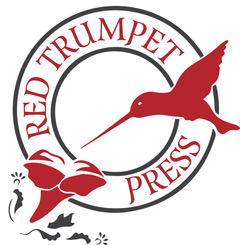The other day I accompanied a gal pal and some of her friends (whom I didn’t know) to the movies. At one point my friend, referring to me, said, “She’s the only person I know who has been to Lithuania!”—to which one of the other women replied, incredulously, “Why would you go there?” I think that pretty much sums up what many Americans think about the Baltic States, but I’m here to tell you those countries are well worth visiting (for their beauty and culture) and studying (for their tragic history, which should be remembered by all of us so that it doesn’t happen again). In my last post I profiled Lithuania; now here’s a snapshot of Latvia:
Part Two – Latvia: Ground Zero for Trade, War, Occupation…and Miracles

Latviatravel.com
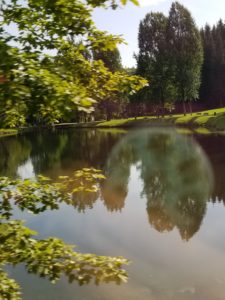
Latvian countryside
Like its Baltic counterparts, Latvia is a low-lying country with abundant forests, plains, lakes and rivers. One would think that with no obvious geographical barrier between them, Latvia and Lithuania would be indistinguishable. Not so. In the case of Latvia, water has dictated the lion’s share of its history. Even though it’s roughly the same size as its southern neighbor, it has more than five times the coastline—and centuries ago, as now, access to the sea and navigable rivers meant everything.
With miles of access to the Baltic Sea’s Gulf of Riga and bisected by the transport-friendly Daugava River, pagan tribes of what’s now called Latvia were already trading in all directions when Teutonic (aka German) crusaders invaded to convert the population to Christianity and in the process take over its trade routes. They established the port city of Riga in 1201 and the area joined the Hanseatic League, an alliance of German merchant guilds that dominated northern European coast trade for several centuries (and which many consider to be the precursor to the European Union).
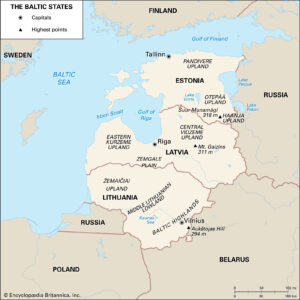
Encyclopedia Brittanica
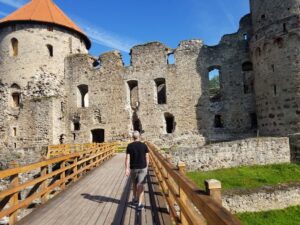
13th century Cesis Castle
As the Germans took over, building castles and lavish manors, they turned the native Latvians into serfs. Influenced by the German priest Martin Luther, the country eventually converted to Protestantism. But the Poles (allied with Lithuania, remember) were stout Catholics, so that led to—you guessed it—war. Then Sweden got into the act, wrestling parts of Latvia from Polish rule. Eventually, Russia, under Peter the Great, took over Latvia entirely.
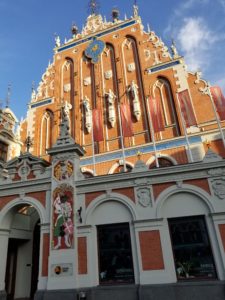
A reconstructed 14th century guild hall
Tzarist Russia, like the Swedish government before it, was a “benevolent” ruler, at least in the beginning. Two centuries of peace prevailed in which serfdom was abolished (1819), Jews thrived, and the German aristocracy was allowed to retain its power in both commerce and culture. But native Latvians still chafed under the occupation, especially when Russia moved to make Orthodox Christianity the main religion and change the national language from German to Russian. When World War I broke out, the country became a major battleground between the Germans and the Russians. What a mess! While the Big Dogs were fighting, Latvians struggled to achieve independence and finally did so in 1918—a shaky, problem-filled period that ended when Soviet Russian troops came to re-take the country in 1940. As in Lithuania, Latvia was overrun by Nazis the following year, and the country lost 95 percent of its Jewish citizens.
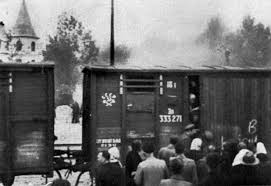
Lativans under deportation from latvians.com
The Soviets returned with a vengeance in late 1944. “Bourgeois” Latvians and “counter-revolutionaries” (freedom fighters) were executed or deported to Siberia, as were farmers who refused to join Russian collectives and anyone accused of “evil-minded laziness” because they were unwilling to work where the central government ordered them to work. (You can watch a chilling (no pun intended) documentary about the Siberian labor camps in Kolyma on You Tube here.) To fill the worker gap, Moscow ordered an influx of ethnic Russians to help turn the country from an agrarian country into a modern industrial state. By the time the USSR neared collapse in 1990, nearly half of Latvia was Russian-speaking, and the Latvian language and culture was in danger of dying out. Fortunately, a nonviolent push for independence had already begun, and Latvia, despite some Soviet pushback, won its current freedom in 1991.
To get a sense of what happens under a socialist economy, and the miracle that is Latvia today, imagine this: prior to World War II, the average Baltic household was richer than households in Sweden. But when the Stalinists took over, all private assets were confiscated, pensions were lost, and money was devalued. All economic decisions were made by Moscow, whose leaders declared they knew better than the people what was good for them. No one could open a business, much less learn the many skills necessary to run a successful enterprise. Democracy was forbidden, and western ideas came only through clandestine radio broadcasts of “Radio Free Europe” and the “Voice of America.” When Latvia finally broke free from its Soviet shackles, it was decades behind the West and among the poorest countries in Europe.
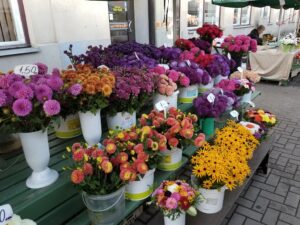 But that fact is changing – rapidly. Private firms and the European Union have invested in the country. In addition to exporting agriculture, textiles and woodworking (remember all those forests), Latvia today is known for manufacturing large-scale machinery and green technology. But one of its fastest-growing sectors is tourism. Riga, the largest and most cosmopolitan city in the Baltics, is very popular with Europeans. It has a large and charming Old Town that reflects the country’s medieval Hanseatic roots, but you’ll find Gothic, Renaissance, Baroque and neo-classical landmarks
But that fact is changing – rapidly. Private firms and the European Union have invested in the country. In addition to exporting agriculture, textiles and woodworking (remember all those forests), Latvia today is known for manufacturing large-scale machinery and green technology. But one of its fastest-growing sectors is tourism. Riga, the largest and most cosmopolitan city in the Baltics, is very popular with Europeans. It has a large and charming Old Town that reflects the country’s medieval Hanseatic roots, but you’ll find Gothic, Renaissance, Baroque and neo-classical landmarks 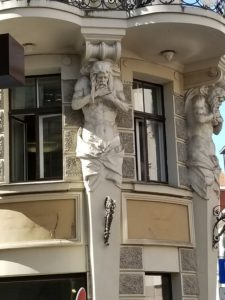 as well. Riga is also renowned for its abundant Art Nouveau architecture, not to mention its nightlife! Latvians love singing, dancing, and all manner of summer festivals. While they aren’t particularly religious (who can blame them after so many religious wars?), they do revere flowers and nature; another area of economic growth is eco-tourism.
as well. Riga is also renowned for its abundant Art Nouveau architecture, not to mention its nightlife! Latvians love singing, dancing, and all manner of summer festivals. While they aren’t particularly religious (who can blame them after so many religious wars?), they do revere flowers and nature; another area of economic growth is eco-tourism.
 Strolling the boulevards of Riga today, there’s no indication (aside from museums) of the oppression Latvians suffered just one generation ago. Instead, there’s a sense of a country on the move, rising to become a self-sustaining member of the EU, eager to be part of the West without sacrificing the culture and traditions that make it unique. If you’re lucky enough to visit this small but sturdy Baltic country, be sure to remember all that its people have been through to get where they are today.
Strolling the boulevards of Riga today, there’s no indication (aside from museums) of the oppression Latvians suffered just one generation ago. Instead, there’s a sense of a country on the move, rising to become a self-sustaining member of the EU, eager to be part of the West without sacrificing the culture and traditions that make it unique. If you’re lucky enough to visit this small but sturdy Baltic country, be sure to remember all that its people have been through to get where they are today.
Check out more photos of Latvia on my Facebook page here.


